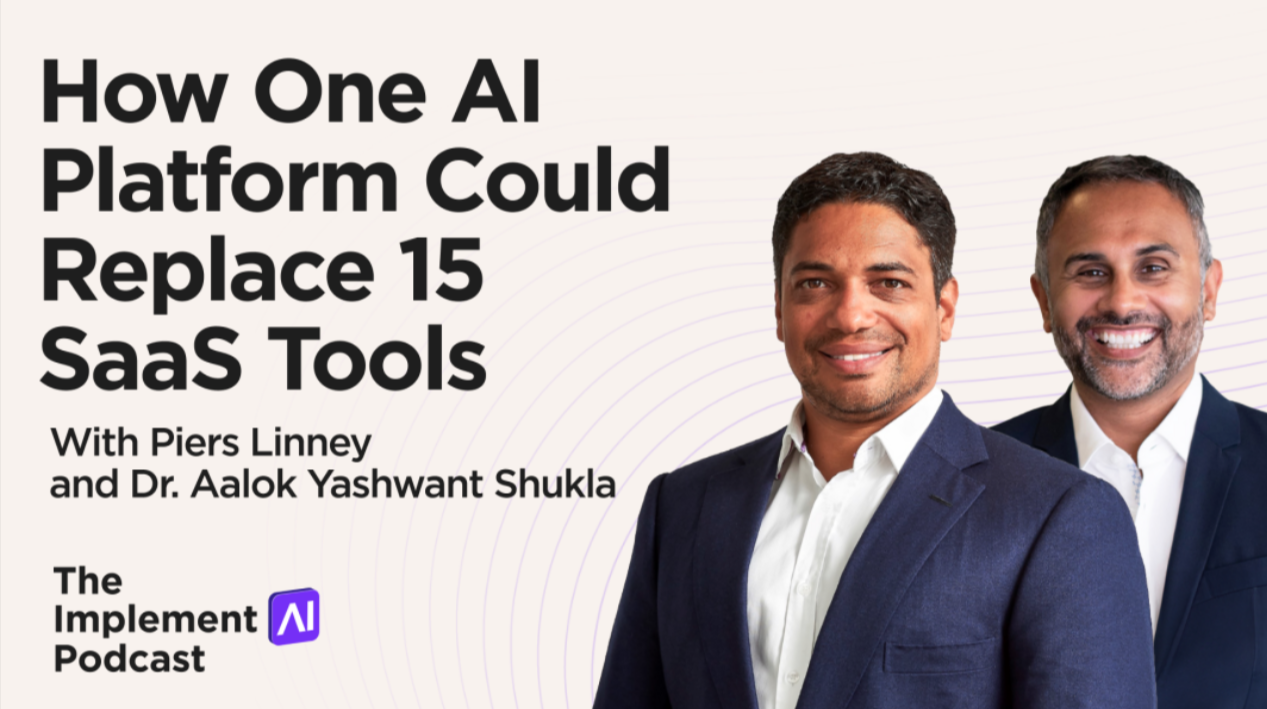The Implement AI Podcast #60 – How One AI Platform Could Replace 15 SaaS Tools
May 14, 2025
The conversation around AI has shifted dramatically in the past two years. While tech headlines focus on the latest breakthroughs and capabilities, business leaders are asking a more practical question:
“What can AI actually do for us today?”
In episode #60 of The Implement AI Podcast, hosts Piers Linney and Dr. Aalok Shukla dive into the real-world state of AI adoption, explore why AI usage still lags in many organisations despite the hype, and offer a clear framework for business leaders looking to implement AI meaningfully.
Spoiler alert: AI is not just about boosting productivity anymore; it’s about completely reimagining how businesses operate.
If you’ve ever felt overwhelmed by SaaS creep (15+ tools all doing slightly different things) or unsure if AI is more buzz than substance, this episode delivers refreshing clarity and a practical path forward.
Where We’re At
Piers and Aalok open the episode with a grounded look at where they’ve been lately, not on the conference circuit, but heads-down building AIOS, their operational AI platform. Their focus? Creating digital workers that slot into businesses just like team members, particularly in the mid-market where companies are big enough to have complexity, but not massive tech teams.
They describe the current moment as the “operational frontier” of AI, the point where AI rubber meets the road. It’s not about what’s theoretically possible; it’s about what actually works in production, today.
The AI Market Trajectory
Piers shares some compelling stats that paint a picture of exponential growth in the AI sector:
- UK AI market: From £300M to £2.8B by 2030
- UAE AI market: 10x growth forecasted
- US AI market: Already hitting $1.6B and expected to grow to $13.5B+
These numbers are probably undershooting the true impact because they’re mostly tracking software spend. What’s harder to measure is the value of replacing or augmenting human knowledge work at scale.
Why So Many Still Don’t “Get” AI
Despite the hype, most businesses aren’t using AI properly or at all. Piers shares that many executives still haven’t even set up a ChatGPT account. He uses AI to double or triple his productivity but notes that using AI and knowing how to use AI effectively are two very different things.
Aalok expands on this: using ChatGPT like spell check is fine but it won’t give you a competitive edge. The real winners are those who understand the domain and know how to prompt AI correctly to generate meaningful, high-quality output. Otherwise? Garbage in, garbage out.
The 4 AI Market Models
Piers and Aalok then break down the current landscape of AI solutions into four main categories:
- Platform Giants (e.g., Microsoft, Google):
- Embedding AI into their existing productivity suites (Copilot, Gemini)
- Often hard to configure or fully utilize for the average business
- Promising but fragmented adoption
- Vertical SaaS AI:
- Niche tools (calendar assistants, AI CRMs, not summarizers)
- Useful for individuals but create data silos
- Contribute to “SaaS creep”
- Open Frameworks:
- Tools like OpenAI’s APIs, open-source models, etc.
- Great for large tech teams (e.g., Shopify, Klarna) who can build custom workflows
- Not accessible to most SMBs
- Horizontal + Managed AI (like Implement AI):
- Deployable digital workers across departments (sales, support, analytics)
- Designed to be plug-and-play for mid-sized businesses
- Unified memory and task engines enable system-wide learning
Piers calls this last model the solution to SaaS overload: 15 tools replaced by one integrated AIOS.
Framework: 3V+R for Evaluating AI Use Cases
The 3V+R framework can help you decide whether AI should augment or replace a task:
- Value: What’s the potential time, money, or strategic upside?
- Variance: How consistent is the input/output?
- Velocity: How fast does the task need to be done, and how much volume is there?
- Risk: Are there regulatory or brand risks in automating this?
This model helps companies categorize tasks into:
- Replace: Low-risk, high volume, predictable tasks (e.g., outsourced call centres)
- Augment: Tasks needing human oversight but where AI can scale output (e.g., sales prospecting)
- Extend: New capabilities only AI can offer (e.g., analyzing thousands of calls or documents at scale)
What AI Is Actually Replacing
Is AI replacing jobs?
It’s replacing roles, not people, especially outsourced providers or repetitive functions. Most businesses aren’t laying off staff, but they are:
- Avoiding new hires in areas AI can cover
- Replacing third-party vendors with in-house AI agents
- Expanding into new verticals using AI-driven outreach
AI lets you test new markets, cover nights/weekends, and launch services you couldn’t afford to build with just human resources.
Final Thoughts
We’re in the dial-up era of AI.
Many leaders are still focused on what AI can do today, not where it’s going in 6-12 months. But AI is moving fast and the companies who treat it as a core competency rather than a gimmick will be the ones who thrive.
It’s not AI that will replace you. It’s the person who knows how to use it properly. Whether you’re augmenting, replacing, or expanding, the message is clear, now is the time to implement AI.
Listen to the new episode on:
- Apple: https://bit.ly/4jVIyJU
- Spotify: https://bit.ly/4mt7QAO
- YouTube: https://bit.ly/4kiD5fX



